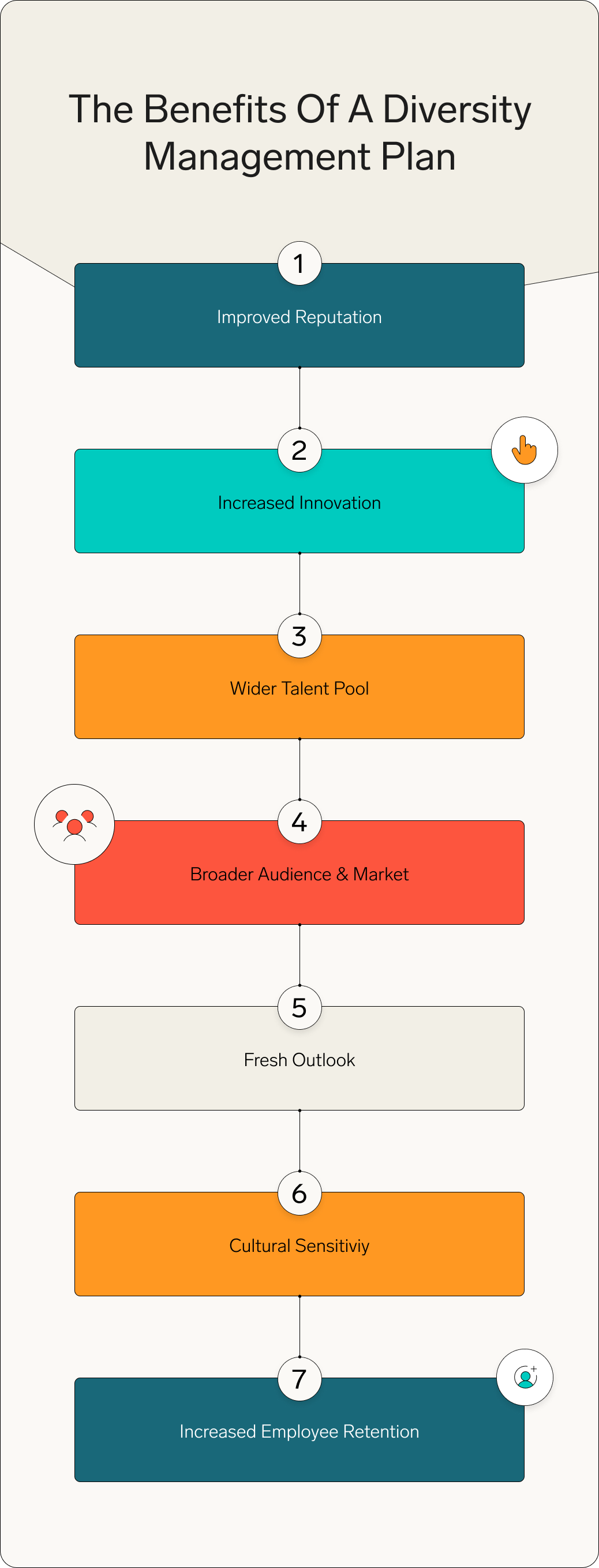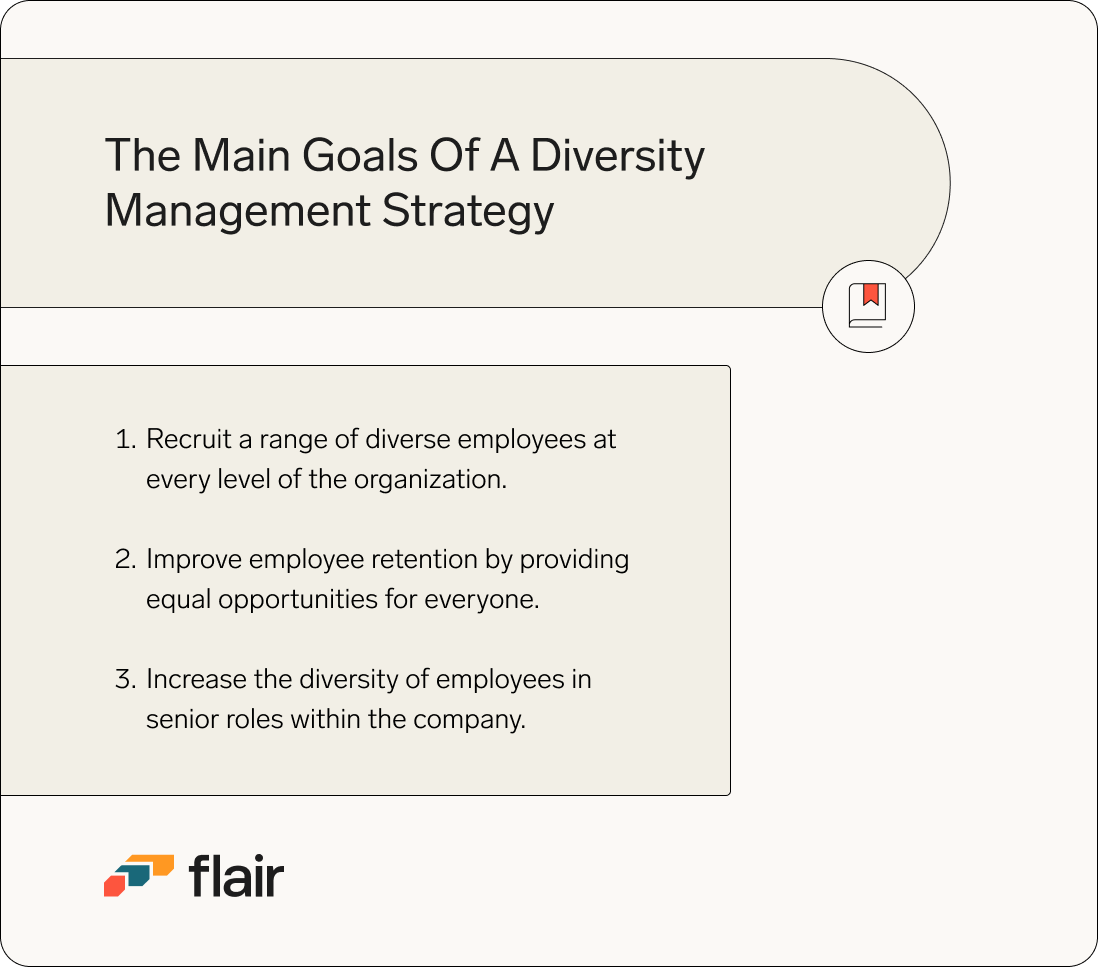Origins to Innovation: Cloud Computing's Impact on HR
Do you know why it's called cloud computing and are you aware of the benefits to HR?
- 06 Jun 2024
- Max 11 min read
The Number One HR Solution on Salesforce
Creating an inclusive environment in the workplace is one of the key elements for business success today. But many organizations are simply paying lip service instead of actively engaging and executing actions to create a truly diverse work culture. This is why it’s important to understand what diversity means and ensure that it is properly implemented within your company.
Establishing a culture of diversity can significantly benefit your company from top to bottom. The first step is to learn about managing diversity through the right initiatives. Since you’re reading this article, you have already taken the first step in showing commitment toward encouraging greater diversity in the workplace, and you will be aware of the many advantages that come with having a diverse workforce.
With the chance for a better work environment, a wider range of employees, and an enhanced reputation, it’s fundamental that your organization understands just how vital diversity management is, and works to implement a successful diversity management strategy.
In this article, we'll outline what it means to be a diverse organization, take a deep dive into some diversity initiatives, and guide you through the process of creating an action plan which will help drive these objectives forward.
Diversity management in terms of human resources refers to the aim of creating a workplace where employees from all walks of life feel included and respected. This includes employees of different gender, ethnicity, religion, sexual orientation, age, or disability, who may have been historically excluded or marginalized. By promoting an inclusive workplace through policies, programs, and increased opportunities, companies can foster an atmosphere of inclusion for everyone.
When promoting Diversity, Equity, and Inclusion (DEI) within your organization it’s important that your approach is thoughtful and intentional. Corporate policies, programs, and initiatives should be implemented via a strategic plan to ensure everyone has the same equal opportunities.
Hiring practices should be kept fair and unbiased while promotion protocols can benefit from being monitored internally to ensure all employees are receiving equal opportunity regardless of their background. Additionally, education should be provided on what kinds of conversations are appropriate in the workplace.
By creating a diverse workforce where everyone feels included and valuable then true success can be achieved.

A diverse workplace has been an ever-evolving concept, with diversity management laying a foundation for long-term success.
In the 1970s, there was a notable increase in the number of women entering the professional workforce. This marked a significant shift in the composition of the workplace and led to a growing recognition of the need for equal opportunities and fair treatment for all employees.
Affirmative Action laws were implemented in North America during this time to address historical inequalities and systemic discrimination. These laws aimed to promote equal employment opportunities for individuals from minority groups, including women, racial and ethnic minorities, and people with disabilities. Affirmative Action measures often involved policies such as targeted recruitment efforts, preferential hiring or promotion practices, and the establishment of diversity programs.
Since then, this movement towards creating a more diverse workforce has spread around the globe, with organizations like CBRE and Maroo for Australians taking proactive steps to promote cultural diversity in their hiring practices. Many businesses are now factoring cultural diversity into their recruitment strategies, though there is still work to do.
The advent of the internet has made it even easier for companies to find highly qualified applicants regardless of their location. Remote working means that businesses can hire talented individuals from any part of the world without physical barriers or time zones restricting them.
Thanks to remote working, job seekers have far greater access to employment opportunities and are able to benefit from an increasingly inclusive environment. These days, almost anyone can find a workspace with a corporate culture that is warm and welcoming, no matter where they happen to be. By bridging geographical boundaries, improved access to employment opportunities and equality in the workplace is within reach.

There are so many benefits to embracing workplace diversity. From tangible, immediate positive impacts, to improving your company’s standing within the industry, recognizing the importance of diversity is key – and it can significantly affect your organization’s bottom line. A study by the Boston Consulting Group (BCG) found that "increasing the diversity of leadership teams leads to more and better innovation and improved financial performance."
When we open our doors to a wide range of perspectives and viewpoints, we create an environment of fresh ideas and innovative solutions. We also have access to a larger talent pool when sourcing candidates. Some of the key benefits of a diverse workplace include:
Traditionally, businesses have predominantly relied on a limited group of individuals to assume leadership roles, overlooking a significant portion of the workforce that can bring diverse perspectives.
Enhancing your reputation through diversity initiatives offers a significant advantage. By embracing diversity in the workplace, you demonstrate to the public that your company is progressive and forward-thinking. A stronger reputation leads to an expanded pool of applicants and a more contented team.
Diverse cultures provide a wider array of potential innovation techniques when compared to relying solely on talent from a single culture or background. Everyone has a slightly different way of doing things, and exposure to different challenges means candidates will likely approach new opportunities differently. The previously mentioned BCG study found that companies with more diverse management teams have 19% higher revenue due to innovation.
Hiring candidates who aren’t just from elite universities in American countries means you will have people on your team who are from different socioeconomic statuses. These people may have a new leadership or corporate culture approach that you hadn’t thought of before. Out-of-the-box thinking is necessary for innovation and it also increases employee engagement.
Similarly, the broader your diversity management program, the greater your talent pool. In a competitive market, this makes a big difference. This allows you to hire more people with different ideas, increasing opportunities within your business.
If you’re looking for a competitive advantage over other companies in your industry, accepting the benefits of diversity will make your company more appealing to top talent. These professionals want to feel respected and have all the opportunities they deserve.
Similarly, demonstrating your dedication to diversity will help your business appeal to a broader market. A survey by Adobe found that 38% of respondents are more likely to consume products and services from brands whose ads represent diversity. Furthermore, some 34% of people have boycotted a company or brand because they don't feel their identities are represented in their advertising.
The growing focus on DEI has given rise to new positions, such as the Chief Diversity Officer, who play a crucial role in shaping inclusive strategies and driving profitability for companies globally. These professionals are encouraged to adopt a fresh perspective on their company's strategy and identify approaches that are both inclusive and financially advantageous.
Exceptional diversity training can significantly improve the work environment. As much as everyone likes to think they know a lot about the world, they are sometimes learning through a very narrow lens. By bringing a diverse range of employees, clients, and customers into your company, you can increase cultural intelligence.
The Human Resources department is responsible for addressing and resolving workplace diversity issues, making diversity management strategies instrumental in reducing the challenges encountered by HR teams. A company that fosters inclusivity and diversity will experience fewer instances of employees being insensitive toward one another.
Furthermore, dedicated policies mean that minority employees will not feel unjustly ignored and discriminated against for promotions or raises compared to their coworkers.
Cutting down on your turnover rate is one of many positive outcomes of increased diversity, and it is an important one. Increased employee retention means less hiring-related costs and a stronger team. It's a reality that when individuals are treated with respect and the work environment is pleasant, they are significantly more inclined to stick around.
Moreover, historically underrepresented professionals frequently find themselves overlooked for career advancement in the workplace. However, a company that places emphasis on diversity will provide them with enhanced opportunities. This can keep employees motivated and equip them with valuable experience for senior positions later in their careers.
The primary goal of better diversity management within the workplace is to create an inclusive, welcoming, and comfortable environment for everybody, whether they are a new hire or part of the senior management structure.
Overall, a successful diversity management strategy will focus on achieving three key outcomes:
Numerous countries have established diversity compliance guidelines that businesses are required to follow and demonstrate their efforts in enhancing workplace diversity. Therefore, ensuring compliance with these guidelines becomes an additional strategic objective that companies strive to achieve

There are a number of different approaches you can use to effectively leverage and manage diversity in the workplace. These strategies aim to create an inclusive environment that values and respects differences among employees. Here are some of the main types of diversity management strategies:
Organizations can ensure diverse representation and equal employment opportunities in their workforce by actively recruiting from a wide range of sources and using inclusive hiring practices, such as skills-based hiring. This may involve establishing partnerships with diverse organizations, implementing blind resume screening, or conducting diversity training for hiring managers. Remember that additional outreach efforts may be required to ensure that a diverse pool of candidates applies to open roles.
Organizations can provide diversity training programs to educate employees about different cultures, identities, and perspectives. These programs promote awareness, sensitivity, and inclusion while reducing biases and stereotypes and help to ensure the long-term adoption and sustainability of a diversity management strategy.
ERGs are voluntary groups of employees who come together based on shared characteristics or experiences, such as gender, ethnicity, or sexual orientation. These groups provide a platform for networking, support, and advocacy. Organizations can support ERGs by providing resources, funding, and opportunities for engagement.
Establishing mentorship and sponsorship programs can help foster a diverse and inclusive workplace. Mentors provide guidance and support to employees from underrepresented groups, while sponsors actively advocate for their mentees' career advancement opportunities.
Organizations can implement fair and unbiased performance evaluation systems that assess employees based on their skills and contributions rather than subjective criteria. Providing constructive feedback and mentorship to all employees can help them grow professionally and ensure equitable treatment.
Encouraging open and transparent communication channels can foster an inclusive work environment. Organizations can provide platforms for employees to share their ideas, concerns, and experiences. This can include town hall meetings, employee surveys, or suggestion boxes.
Creating a diverse and inclusive workplace requires commitment from organizational leaders. Organizations can establish diversity and inclusion goals, hold leaders accountable for meeting those goals, and ensure diversity in leadership positions. This sends a message that diversity is valued at all levels of the organization.
Providing flexible work arrangements, such as remote work options or flexible hours, can support employees with diverse needs and responsibilities. These policies help create an inclusive workplace that accommodates different personal circumstances.
It's important to note that the specific strategies and their effectiveness can vary depending on your organization's size, industry, and cultural context. In order to implement a sustainable and successful diversity management strategy, you should tailor it to your team’s specific needs and regularly evaluate its effectiveness to make necessary adjustments.
When implementing a diversity management strategy it’s normal to come up against some challenges.
It’s common to encounter resistance or lack of buy-in from employees or leadership, which can hinder progress. Changing ingrained attitudes and behaviors is possible, but it requires a commitment to ongoing education and plenty of open dialogue.
Additionally, biases and stereotypes may persist despite efforts, leading to unconscious discrimination and exclusion. Constant vigilance and training can help to mitigate these biases and ensure sustainability in your diversity management practices.
Finally, measuring the impact and effectiveness of diversity initiatives can be challenging, making it difficult to assess progress and make informed decisions. Therefore it’s crucial to think about which metrics you will use to measure success when planning and implementing a diversity strategy.
Ensuring the sustained commitment and allocation of resources from top management is crucial for the long-term success of diversity management strategies. Overcoming these challenges demands consistent effort, engagement, and a culture of inclusivity throughout the organization, but the payoff is hugely rewarding.

Once you understand the possible challenges that your organization may face when working to increase workforce diversity, you can start to consider how to implement a new diversity management strategy. No matter the size, every business can benefit from exceptional diversity management protocols such as these:
Foster an environment where employees feel safe to express their ideas, concerns, and experiences by prioritizing open and transparent channels for dialogue. Implementing regular team meetings, town hall sessions, or dedicated diversity forums can provide platforms for discussions. Additionally, creating feedback mechanisms, such as suggestion boxes or anonymous surveys, can encourage employees to share their perspectives. Effective communication also includes actively listening to diverse viewpoints, promoting active dialogue, and providing timely and transparent updates on diversity initiatives. By valuing and encouraging communication, organizations can foster understanding, collaboration, and a sense of inclusion among employees.
When fostering diversity management, it is imperative to embrace the principle of treating employees equally. However, it's important to recognize that unconscious biases can unintentionally influence our interactions. Despite our good intentions, our language and actions may inadvertently be perceived as offensive or condescending to individuals from diverse backgrounds. Therefore, it's crucial to cultivate self-awareness, challenge preconceived notions, and continuously educate ourselves to ensure that our behaviors align with our commitment to equality and respect for all employees. By actively addressing and mitigating these potential pitfalls, we can create a truly inclusive and supportive work environment.
Encouraging diverse group work is another valuable strategy in diversity management. Corporate diversity training emphasizes the importance of engaging with individuals outside of our usual circles. A diverse group of employees collaborating on projects offers a unique opportunity to tap into a wide range of skills and perspectives that would otherwise be overlooked. Moreover, it fosters meaningful connections among coworkers who may not have interacted otherwise, leading to enhanced collaboration across departments. By actively promoting and facilitating diverse group work and mentoring programs your organization can unlock the full potential of employees while cultivating an inclusive and collaborative work environment.
Employing consistent standards for evaluating employees can ensure fairness and inclusivity throughout the workforce, minimizing the risk of discrimination accusations. Objective measures promote a sense of equal treatment, which is essential for maintaining a diverse and welcoming environment. This principle also extends to preparing employees for senior roles. When mentoring young and promising talents, it is crucial to evaluate them based on the same standards applied to all employees. Avoiding favoritism or leniency based on background or personal connections is essential to building harmony among team members and promoting a culture of meritocracy. By emphasizing objective measures, organizations can reinforce transparency, accountability, and equal opportunities for all employees.
When encountering new employees, it is essential to consciously set aside any biases or preconceptions and approach them with a genuine desire to understand and appreciate them as individuals and professionals, rather than focusing solely on their background.
That being said, it's also important to recognize the value of acknowledging and embracing diverse backgrounds. Different perspectives shaped by various experiences can enrich discussions and decision-making processes. By actively listening to your employees' thoughts and feelings, you can gain valuable insights that contribute to a more comprehensive understanding of their viewpoints. This inclusive approach allows for a deeper appreciation of the diverse talents and contributions individuals bring to the table. Keep an open mind while also creating a space where everyone's unique perspectives are valued and respected.
A diverse workplace is not just a trend; it has become an essential consideration for companies that want to thrive and maintain a positive reputation. Understanding effective diversity management is a crucial factor in the success of your business. By embracing a diverse range of talent from various backgrounds, you can infuse your organization with a global perspective that enables you to tackle challenges from unique angles. Whether you are a large enterprise, an international organization, or a small, ambitious startup, prioritizing diversity at work is crucial in today's interconnected world. Embracing inclusivity and cultivating a welcoming, professional environment will help your company reach new heights of success.
As the leader of an HR department or organization, your openness to diversity is an excellent first step, and the next step can involve exploring how an HR management tool like flair can support your work. By automating repetitive processes and with a wealth of tools for improved communication and collaboration, flair can help you focus on the growth and development of your employees.
Book a demo today and discover how flair can streamline your HR processes and empower you to nurture your employees!
Join flair’s newsletter to receive the latest tips & trends in the HR world.

